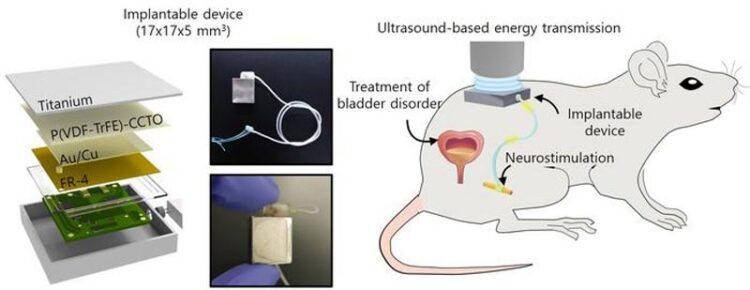Using static electricity to enhance biomedical implant durability

Implantable medical device utilizing electrostatic materials with high dielectric properties for ultrasound energy transmission.
Credit: POSTECH
Medical technology innovations achieved by integrating science and medicine have improved the quality of life for patients.
Especially noteworthy is the emergence of electronic devices implanted in the body, such as in the heart or brain, which enable real-time measurement and regulation of physiological signals, presenting new solutions for challenging conditions like Parkinson’s disease. However, technical constraints have hindered the semi-permanent use of electronic devices after their implantation.
A collaborative research team led by Professor Sung-Min Park from the Departments of Convergence IT Engineering, Mechanical Engineering, and Electrical Engineering, and the School of Interdisciplinary Bioscience and Bioengineering at POSTECH, alongside Jiho Lee, enrolled in the MS/Ph.D. program, and Professor Sang-Woo Kim from Yonsei University’s Department of Materials Science and Engineering, together with Dr. Young-Jun Kim and MS/Ph.D. student Joon-Ha Hwang from Sungkyunkwan University, has achieved a groundbreaking development. They’ve created electrostatic materials that function even with extremely weak ultrasound, heralding the era of permanent implantable electronic devices in biomedicine. This research has been published in the international academic journal Advanced Materials.
Patients with implanted devices need to undergo periodic surgeries for battery replacement. This process carries a significant risk of complications and imposes both economic and physical burdens on patients. Recent research explores implantable medical devices that operate wirelessly, yet finding a safe energy source and protective materials remains challenging. Presently, titanium (Ti) is used due to its biocompatibility and durability. However, radio waves cannot pass through this metal, necessitating a separate antenna for wireless power transmission. Consequently, this enlarges the device size, creating more discomfort for patients.
The research team addresses this issue by opting for ultrasound, a safety-validated method in various medical fields for diagnoses and treatments, instead of radio waves. They developed an electrostatic material capable of responding to weak ultrasound by utilizing a composite of high dielectric polymers (P(VDF-TrFE)) and a high dielectric constant ceramic material known as calcium copper titanate (CCTO, CaCu3Ti4O12). This material generates static electricity through friction between its material layers, producing effective electrical energy, and possesses an extremely low output impedence, facilitating efficient transmission of the generated electricity.
Using this technology, the research team created an implantable neurological stimulator powered by ultrasound-based energy transmission, eliminating the need for batteries. This was confirmed through experimental validation. In animal model trials, the device was activated even at standard imaging ultrasound levels (500 mW/cm2), imposing minimal strain on the human body. Furthermore, it effectively mitigated symptoms related to abnormal urination caused by overactive bladder disorders through nerve stimulation.
Professor Sung-Min Park stated: “We have addressed the challenges in the field of implantable medical devices using ultrasound-based energy transmission technology that is harmless to the human body. This research serves as a case of introducing advanced material technology into medical devices, and we anticipate that it will promote the emergence of a next-generation medical industry, including the treatment of intractable diseases using implantable devices.”
Professor Sang-Woo Kim remarked: “Devices manufactured based on highly biocompatible materials exhibit excellent mechanical and chemical stability, making them suitable for treating various diseases requiring long-term therapy. Non-battery, miniaturized components with established long-term stability are expected to bring forth new innovations in the market of human-insertable medical devices.”
The research was conducted with support from the Research Leader Program, Pioneer Program of Future Technology, and Bio & Medical Technology Development Program by the National Research Foundation of Korea and the Ministry of Science and ICT, along with Yonsei Fellowship.
Journal: Advanced Materials
DOI: 10.1002/adma.202307194
Article Title: High-Performing and Capacitive-Matched Triboelectric Implants Driven by Ultrasound
Article Publication Date: 26-Oct-2023
Media Contact
Jinyoung Huh
Pohang University of Science & Technology (POSTECH)
jyhuh@postech.ac.kr
Office: 82-54-279-2415
All latest news from the category: Medical Engineering
The development of medical equipment, products and technical procedures is characterized by high research and development costs in a variety of fields related to the study of human medicine.
innovations-report provides informative and stimulating reports and articles on topics ranging from imaging processes, cell and tissue techniques, optical techniques, implants, orthopedic aids, clinical and medical office equipment, dialysis systems and x-ray/radiation monitoring devices to endoscopy, ultrasound, surgical techniques, and dental materials.
Newest articles

First-of-its-kind study uses remote sensing to monitor plastic debris in rivers and lakes
Remote sensing creates a cost-effective solution to monitoring plastic pollution. A first-of-its-kind study from researchers at the University of Minnesota Twin Cities shows how remote sensing can help monitor and…

Laser-based artificial neuron mimics nerve cell functions at lightning speed
With a processing speed a billion times faster than nature, chip-based laser neuron could help advance AI tasks such as pattern recognition and sequence prediction. Researchers have developed a laser-based…

Optimising the processing of plastic waste
Just one look in the yellow bin reveals a colourful jumble of different types of plastic. However, the purer and more uniform plastic waste is, the easier it is to…



